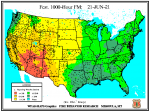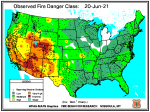Just thought there may have been a possibility for NF or BLM to use the State microwave system for remote tac receivers. Any idea what the gain is on the mountain top repeater antennas?
The federal wildland fire agencies do not monitor tac frequencies from any base stations. They are strictly mobile/handheld to mobile/handheld channels only. Incidents are divided into geographical units, divisions and branches. One criteria for a division is that handheld to handheld communications is possible for all resources assigned to that division. If topography does not allow that then another division is established. An area that has topography that blocks simplex communications is too large for a division supervisor to handle. A base station does not need to receive or transmit on tac frequencies. That is what command nets are for. On large fires a command net is established using the NIFC system. One or more portable repeaters are set up and the Incident Command Post can transmit/receive on all the repeaters on this net. Dispatch centers are not connected to this net. If some command personnel need to communicate with the dispatch center they do so on NF and BLM district nets. Those dispatch centers are nearly overwhelmed with work ordering all the resources the incident is generating. Prior to being overwhelmed they begin a process to set up what is called "Expanded Dispatch," which is a larger organization than the dispatch center usually has. Outside personnel are brought in so that tasks can be split up among several people. Expanded dispatch has its own structure based on the type, size and complexity of the incident. Most ordering is done by computer using ROSS (Resource Ordering and Status System) software. If there isn't cell phone/internet coverage at the ICP then this has to be done by radio. In California the USFS set up Service Nets for that. However, cell phone/internet service is usually a major factor for selecting the location of ICP's. If it is lacking at an ICP site then radio techs set up satellite links for both. ICP location is a part of fire management planning. Coordination with school campuses, regional parks and other suitable areas is done annually. ICP locations out on national forest and BLM lands are identified in plans. These locations are picked given the transportation system, water supply, communications capabilities, sleeping areas, dining areas, command trailer areas, etc. When an incident is getting past initial attack, longer term and more complex command people usually have these areas in their heads. This often gets handled by National Forest Fire Management Officers, their staff or BLM District FMO's and staff so the ranger district and field office fire management can take care of the immediate situation.
There is a huge amount of work done that no one sees unless they are in the offices of these agencies. I was the frontcountry recreation supervisor on a very heavily visited ranger district that had a major fire. It started on August 20th, in the peak of summer visitation. I had a pretty good level of ICS qualifications and experience so I had a large workload during the whole thing. It took the focus of nearly every person on ranger district for nearly 6 weeks. The first 2-3 weeks of that was a 7 days a week, 12 or more hours per day effort. For me it was all about people management, which got complicated due to a large area of closure that we maintained until the first major snowstorm. The district received a group performance award for recognition, which unlike most performance awards, did not come with any extra compensation. Many of us had overtime, but the level of exhaustion was immense, both physically and mentally. Once the snow fell, I took a 2 week vacation across southern Arizona and California, camping/hiking/sightseeing and doing some maintenance on a family second home property.
As for using state microwave sites, realize there are far more USFS and BLM repeater sites than state microwave sites. Often times the USFS and BLM have repeaters and/or remote bases located at those locations where the state microwave system has equipment.
It seems like you have an urban perspective of communications. Rural and federal public land management agency communications have a number of differences. Emergency incidents have a well known structure, that is how all of us work together. Communication channels and systems are there to meet the needs of the incidents. These systems don't need any additional assistance to function.



